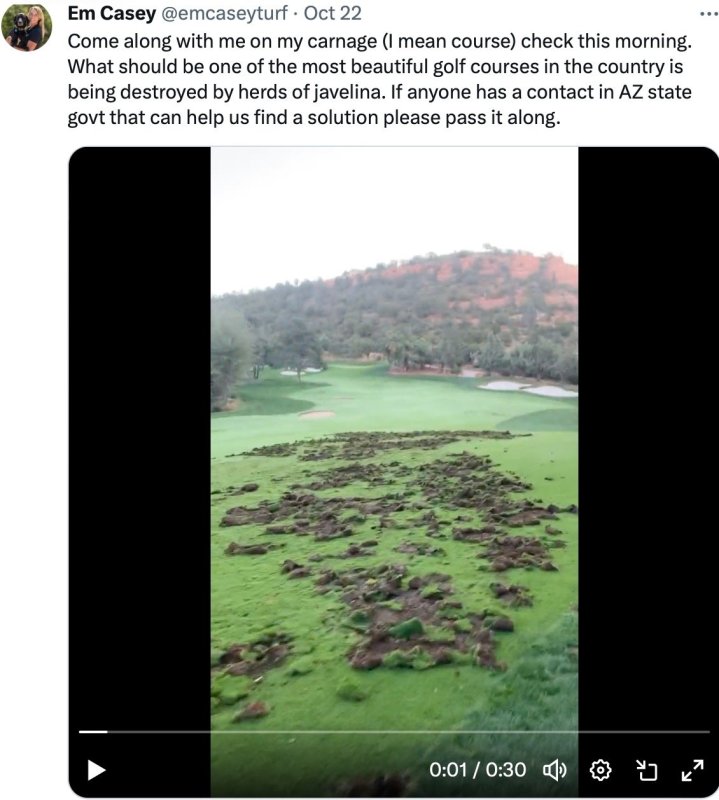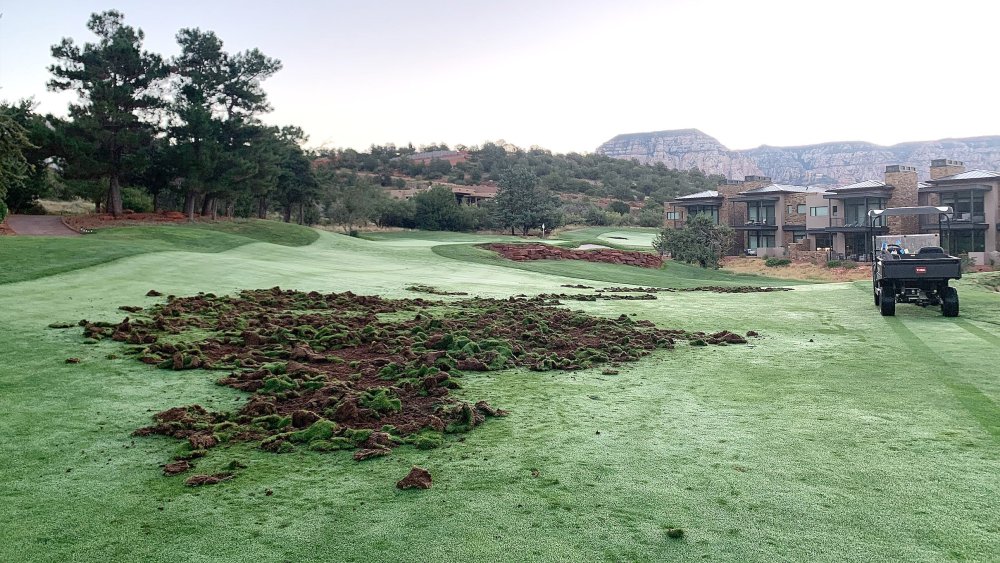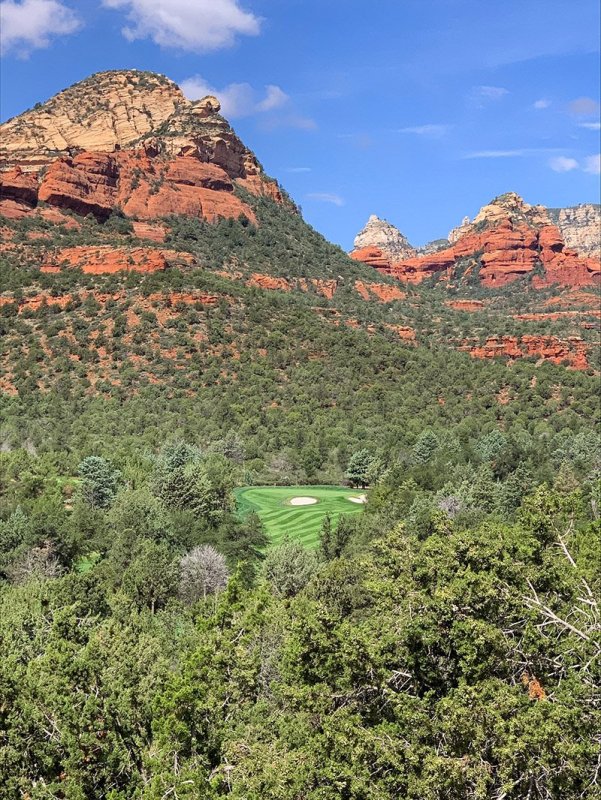If this whole golf course maintenance thing doesn't work out for Emily Casey, she might want to consider a career as a social media influencer.
Casey, the assistant superintendent at Seven Canyons Golf Club in Sedona, Arizona, is the owner of the infamous video with nearly 33 million views on the site formerly known as Twitter that shows damage caused by javelinas. That's right, 33 million.
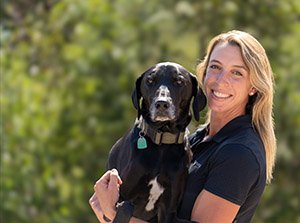 "I know, it's crazy. I was expecting maybe a few thousand views, not 30 million," said Casey (right) laughing. "It's not even a good video. It's loud and it's shaky and it's recorded on an iPhone X. I'm not even a social media person."
"I know, it's crazy. I was expecting maybe a few thousand views, not 30 million," said Casey (right) laughing. "It's not even a good video. It's loud and it's shaky and it's recorded on an iPhone X. I'm not even a social media person."
You are now.
The video shows the result of a herd of javelina, which are native to Arizona, peeling back turf in search of a meal underneath the surface.
"We've done all our apps for grubs, and we haven't found a grub on the golf course," Casey said. "We think they're going for earthworms."
The feedback the video has generated runs the gamut from supportive and sympathetic to callous and repugnant.
Some offered thoughts and prayers, others suggested solutions to help heal the course. At the other end of the spectrum were those who concluded that Arizona is no place for a golf course, anyway, and the staff and members at Seven Canyons sort of got their comeuppance. There were even some who said Casey couldn't tell the difference between a collared peccary (the javelina's official moniker) and a feral hog.
Ultimately, like most social media influencers, Casey was forced to limit responses on the thread and even stepped away from the unplanned notoriety.
"Yeah, I've had to take a break from it," Casey said. "I've stopped checking my messages. It's been a little much."
Prior to Oct. 22, the most popular video on Casey's account was a Jan. 20 clip of a northern Arizona snowstorm that to date has collected more than 480,000 views.
"I thought that was a lot," she said. "And that was just a snowstorm. This was different."
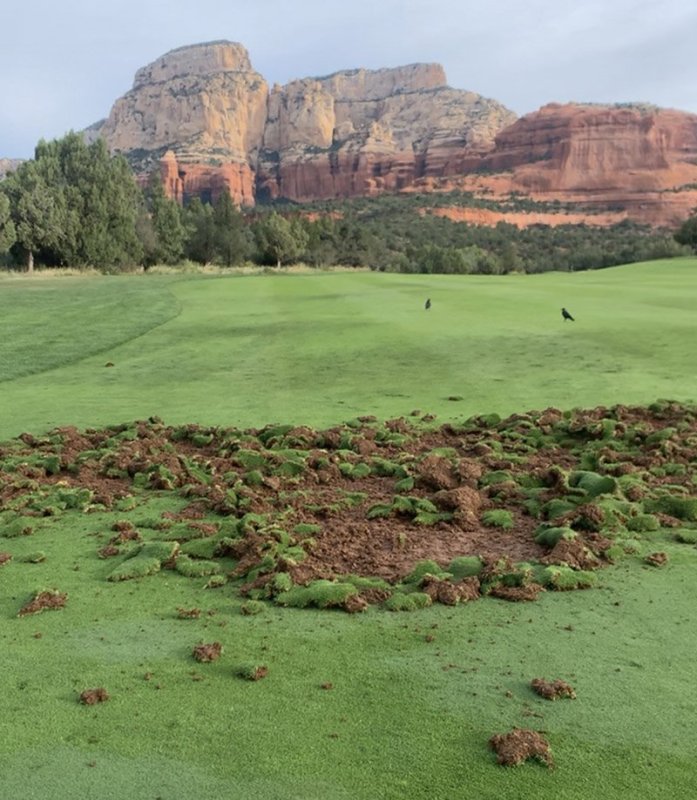 The recent javelina video rapidly brought a very bright spotlight, wanted or not, onto Seven Canyons.
The recent javelina video rapidly brought a very bright spotlight, wanted or not, onto Seven Canyons.
"I've been posting videos of javelinas for the last few months, and no one has ever noticed," Casey said. "I posted this one on a Sunday, and by the time I came into work on Monday morning, it had more than 3 million views. I thought 'Oh, man.' "
Andy Huber, her boss and the superintendent at Seven Canyons, was headed to the airport that day for a conference. Casey told him she'd sent him a text message when the video reached 10 million views.
"By the time his plane landed it was at 15 million," she said.
And his response?
"Oh, no. That might be publicity we don't want."
"At first, I was a little nervous," she said.
"It's been a lot of publicity, but most of it has been positive. Now, we just laugh at it."
Members not only have gobbled up the notoriety their golf course has received, many have pitched in to help repair the damage. That's a good thing, considering the javelina show up almost daily during the hot, dry months. When the javelina are most active, the Seven Canyon crew spends 100-150 hours a week repairing turf in fairways and rough and on tees and approaches.
"The members have been great," she said. "It's been nice to have the support of the members."
So, just what is a javelina, or collared peccary?
Some in Casey's conversation wondered, or even claimed, that they are related to pigs, but they're not. As disgusting as pigs are, javelinas are even worse, said Casey, a Penn State graduate who has learned a lot about them since she arrived in August 2022 at Seven Canyons.
"They stink," Casey said.
Unrelated to pigs, javelinas are native the American Southwest with a natural range that extends south through Mexico and Central America into South America. They are considered game in Arizona with a strictly regulated hunting season that spans January and February.
That rules out the advice offered by so many on X who suggested a poison or even what caliber of ammunition would be best to wipe them out.
Even those who hunt them legally during season are permitted only one per tag.
"They're native to here, just like deer," she said. "And we wouldn't just blow away deer."
They're native like deer with the odor of a skunk, leading some to call them "skunk pig."
A scent gland on the javalina's rump emits a strong odor that most find repulsive but javelina consider inviting. They rub their rears on trees to mark territory, and they rub it on other javelina to identify members of their herd, which can number up to 50 or more.
"It's nasty," Casey said. "If you hunt them and get their oils on the meat, it spoils the meat. And if you hit that scent gland, forget it. You just have to leave it for the coyotes, and they probably won't even touch it."
In the meantime, the javelina run roughshod over Seven Canyons almost daily. When Casey posted a time-lapse video of the Seven Canyons crew repairing damage, viewers noted how they'll just return and damage the same area.
"That's what they do. They come right back the next day," she said. "We have to laugh about it. If you don't, you'll cry."
Javelina activity is dependent on weather. They are less active - at least on the golf course - during rainy periods and throughout the winter.
"When it's hot and dry, they're here almost every day," Casey said. "Last summer we had a lot of rain, so we didn't see too many."
With overnight temperatures in the 30s in northern Arizona, the javelina finally are becoming less visible at Seven Canyons. When winter hits, they'll disappear.
"I think now they're just loading up, getting as many earthworms as they can before winter," Casey said. "When it's freezing, there's nothing here for them."
With each visit, they hit the same cluster of holes. They're favorite run includes holes 9, 11, 15, 16 and the practice range.
"It looks worse on video than it is," Casey said. "They're like animal sod cutters. They roll up the turf and we just roll it back - at least in the fairways. The rough is the worst, we've had to shut down trying to repair the rough until they go away."
To minimize future damage, the club is soliciting bids to complete fencing of the property.
"Traps don't work. They're very territorial. Once one herd leaves, another one will take right over," Casey said.
"The club is partially fenced. We're taking bids right now to see who can complete it ASAP."


